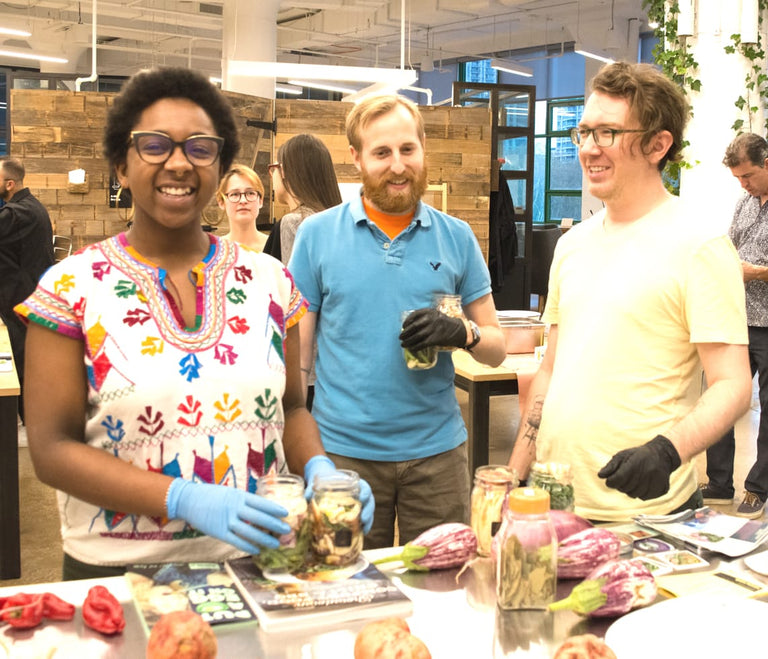Meet Your Farmer: Brooklyn Grange
Next time you’re walking down Flushing Ave in Brooklyn, look up. You might see a glimpse of a rooftop farm growing your Local Roots salad mix and micro greens. The Brooklyn Grange Rooftop Farm is the world’s largest soil rooftop farm in the world and a pioneer in urban farming. In addition to growing and distributing fresh local vegetables to Local Roots NYC and our city’s best restaurants, Brooklyn Grange also hosts events and educational programming, provides urban farming and green roof consulting and installation services to clients worldwide, and partners with numerous non-profit organizations throughout New York to promote healthy and strong local communities.
We were able to sneak in some time with one of their farm manager’s, Michelle Cashen, to offer you a deeper insight to fellow New Yorkers who are growing your food, right here in the city.
1. What are some tips or things you do in the kitchen that help you cook when you have limited time?
I wish I was crafty enough in the kitchen to answer these two but I find I struggle all the same with making quick meals or keeping the kitchen organized. I do try to keep the essential cooking utensils or ingredients (like wooden spoons or salt) within reach, but I doubt that’s a novel practice. When I am in a rush to make a meal, I usually stick with the basics – scrambled eggs or a salad of whatever vegetables are in my fridge. Having fun add ons like kimchee (my roommate recently bought the one from Hawthorne Valley Farms and I’m obsessed because it’s not super spicy), or microgreens, from Brooklyn Grange of course, keep staples like eggs on toast from getting too monotonous.
What’s the most challenging part about being an urban grower?
There’s a long list of challenges when it comes to urban farming, but the hurdles overlap with that of rural farmers, such as expensive tool upgrades, a constant lack of sufficient time, etc. One unique challenge however that’s unique to rooftop farming is elevator access. At Brooklyn Grange we share a freight elevator with many other businesses who are just as busy as we are. Sometimes waiting for that freight or worse, when there’s mechanical failure and it’s turned off for the day, can really throw a wrench in your plans when there’s a lot of other work to be done but we need to get out harvest out for deliveries.
What’s the most rewarding aspect of being an urban grower?
The most rewarding aspect of farming at Brooklyn Grange is having the opportunity to work with such amazing people. That might be a cliche, but it’s the truth. Our team is made up of some of the smartest, funniest, and most talented folks around.
We offer your micro greens to our members and we’d love to know why did BK Grange start growing micro greens, and what are their health benefits?
There are a few reasons Brooklyn Grange started growing microgreens. Because they’re grown in our greenhouses, we are able to produce them year round unlike our field crops. Their production gives our company a more steady stream of revenue year round and keeps us better connected to chefs and restaurants during the off season.
Microgreens also provide an additional purpose to our greenhouses during the typical growing months. Before we started our microgreen operartion, our greenhouses were used solely for starting all the crops we would later transplant (such as tomatoes, cucumbers, kale etc). When the last of those crops are put out into the field around the beginning of June, the houses would mostly be sitting idle. Microgreens allow us to utilize a previously underutilized space, optimizing every square foot of our roof.
There are studies out there that show microgreens pack more nutrients into their leaves than fully grown vegetables but I could not cite them for you nor could i provide the specifics of those studies.
How long does it take for micro greens to grow from planting to harvest?
Harvest time for microgreens vary depending on the crop and time of year. For mustards like arugula and mizuna, it takes about two weeks. For celery, it could take as long as four weeks. In the summer, everything grows slightly faster, but during the winter when there is less light and warmth, all the crops slow down.
What is one thing you wish people knew about growing or eating micro greens?
One thing people may not realize about growing microgreens is that it’s not easy! Especially during the Winter. They need constant attention and monitoring – for example are they getting too much water or too little? Too much means root rot, but too little and the leaves wilt. Identifying and providing consistent optimal conditions are two separate and sometimes quite tricky aspects of producing microgreens.
What is the easiest way for people to make the transition from buying veggies at the super market, to buying from a CSA or farmers market?
I think one way to make the transition into buying a CSA share or buying your vegetables from a farmers market is by talking to current CSA members or the farmers about how to use those vegetables. That’s also what makes these two alternatives to shopping at a grocery store more fun – it’s a more personal, social experience, and it’s free advice! What’s celeriac and how do I use it? When Jerusalem artichokes are in your share, be careful when you choose to eat them since they can make you gassy… =)
What do we have to do in order to reshape the current system of farming?
There’s a lot of things that need to be done and it’s frankly overwhelming, but I think one of the most important things that everyday consumers can do is buy directly from farmers. Go to your local farmers market or purchase a CSA share. Find out which grocers in your neighborhood source directly from local farms. By supporting local farms you are voting with your dollar for a more sustainable food system; one that reduces the miles your food travels from farm to plate, one that supports family owned and/or small businesses and keeps money within your community, and one that takes into account the longevity and fertility of our land and its soil. Changing our food system may come to mean different things, but no matter what it has to start with the choices we each make everyday.
You can tour either of their 2 farm locations by reserving a spot on their website for just $10. Want their greens? Order our Salad Mix share during the Summer and Fall seasons.
Article contributed by Rebecca Stone. Photo courtesy of ©Brooklyn Grange Rooftop Farm
Rather have a taste first?
Local Roots Experiences are fun, pop-up events where we bring the farm to you!

Become a Harvest Club Pick Up Location
Are you a NY based cafe, bar, or neighborhood business? Become a Harvest Club pick up location and have community members come to your establishment each week to pick up their Local Roots harvest.
Top






